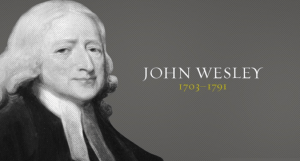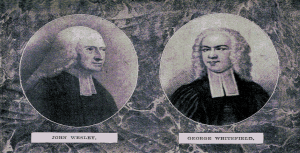John Wesley and the History of Methodism
By Paul Romon
This story map traces 10 notable events in Wesley’s life that demonstrate his evangelism and his impact on the foundation of Methodism. Using quotes from his journal (The Journal of John Wesley), the map combines his words with drawings, paintings, and pictures that relate to the specific event. The map chronologically illustrates Wesley’s life from 1729-1749. The story map includes his experiences in his short stay in America and his lengthy tenure as a popular religious figure in England.
The Early History of the Methodist Society

http://www.christianitytoday.com/history/people/denominationalfounders/john-wesley.html
John Wesley’s Methodist society was one of the most impactful and long lasting outcomes of the Great Awakening. Wesley’s religious journey from 1729 to the 1780s coincides with all of the major events of the Great Awakening and you could say that his life span equaled that of the Great Awakening. To remind you, the Great Awakening was an extended historical period that included countless evangelical movements that challenged traditional ideologies of the 17th and 18th century church and was essentially a religious battleground of competing religious ideas and mass conversions. I want to focus on one subject – John Wesley and the evolution of Methodism. Wesley was a key antagonist to other evangelical movements and his ultimate goal was to separate his society from the other popular movements of the time.
After many hours of research through Wesley’s personal journal and various university libraries’ digitized documents, I have organized some of the most significant events that represent the history Methodism and the life of John Wesley.
John Wesley’s entrance into the Great Awakening began in November of 1729 at Pembroke College at Oxford. At Oxford, Wesley and his brother “read over the classics…and on Sunday some book in divinity.” [1] While to the non-historian these weekly meetings of the “Holy Club” seem benign, the unique brotherhood of the group and level of religious enthusiasm was a tiny embryo to Wesley’s epic journey through the Great Awakening. Only six years later, Wesley decided to sail to America to convert Indian communities. Wesley was so inspired by the discourse of the Holy Club meetings that he sailed over 4,000 miles to foreign terrain with foreign governments. On February 2nd, 1739, Wesley landed on St. Simons Island – a mostly uninhabited land and began his short-lived missionary attempts in the colonies. Upon landing, Wesley over estimated his ability to convert the Indians and meanwhile he butted heads with colonial authorities in Savannah. But, Wesley was zealous and held himself and others to the strictest moral conduct and people in the colonies were not used to his level of religious fervor and his notions of religion were alien to colonial congregations. As a result, on August 7th, 1737, Mr. Causton, a judge in Savannah, issued a warrant for Wesley’s arrest because Wesley “repelled Mrs. Williamson (a member of his congregation) from the holy communion.”[2] Wesley subsequently fled back to England and never returned to the colonies.
Shortly after his return to England, Wesley discovered that there were more effective means of spreading his message through such mediums as public speaking and print. In May of 1739, Wesley stood in awe of George Whitefield (another Great Awakening celebrity) because of his ability to preach in a public setting and rally a new type of discourse that was not accessible in the conventional church setting. Thus, the day after Whitefield left town, Wesley “began expounding our Lord’s Sermon the Mount (one pretty remarkable precedent of field-preaching).”[3] Wesley’s public speeches were a tool that was paramount to his popularity and ability to convert mass audiences. These public demonstrations functioned in the same way as a political rally does today. Shortly after, in May of 1740, Wesley published one of these open-air sermons called The Free Grace Sermon. This printed sermon was unique in that was in fundamental conflict with George Whitefield’s more Calvinist beliefs that privileged the wrath rather than the benevolence of God. Thus, through the medium of print, Wesley attracted a wider audience and laid the blueprint for what would become a new denomination that lasts to this day – in fact my college (SMU) exists because of him.

Equipped with new tools in public speaking and printing and an enthusiasm for God’s love that was contrary to many other religious movements of the era, Wesley toured the streets and churches of England and Ireland to gather support. In 1743 after a meeting with members of his newly formed “United Societies,” Wesley published: The Nature, Design, and General Rules of Our United Societies. Wesley scholar Andrew Thompson writes: The rulebook “explain[ed] the purpose of a Methodist society, [and laid] expectations for ongoing participation in the society.”[5] This was a monumental event for the formation of the Methodist church because he created formal, concrete rules and guidelines – something that some other movements lacked. Shortly after, Wesley held the first annual Methodist conference at the Kings Foundry on June 25th, 1744 in what was then Moorsfield, England.
The next year, on July 4th, 1745, a constable issued a warrant for his arrest after he broke his promise to not preach for 30 days in Cornwall, England. He was also charged with inciting riots because many of his religious ideas mixed with politics and he proclaimed that one must love the king in order to love God.[6] After the warrant was issued, angry mobs followed him through his rock star like tour. In a similar circumstance in 1749, an angry mob followed him into the streets of Bolton, England, and seemed ready to beat him up and end the movement. “We had no sooner entered the main street than we percieved the lions at Rochdale were lambs in comparison to those at Bolton.”[7] When the mob followed him inside, Wesley called for a chair and made a speech, and, to his surprise, “they devoured every word.” Miraculously, he gained the respect of the same mob that was ready to kill him. This remarkable scene is one of many examples of Wesley’s charisma and ability to inspire large audiences. [8]
This very brief overview of Wesley does not do justice to the strength and charisma and impact of John Wesley during the Great Awakening. And, his movement did not see a true rise to popularity until the 19th century. But, the subject of Wesley and the Methodist church is something that anyone (pedestrian inquirer of the Great Awakening or historian) must consider as incredibly important and indicative of the religious fervor of the era.
Further Reading
1.) The Journal of John Wesley
4.) The Nature, Design, and General Rules of Our United Societies
5.) The Letters of John Wesley
6.) Index of John Wesley’s Sermons
7.) The Practical Theology of the General Rules
Notes
[1] Image url: http://www.christianitytoday.com/history/people/denominationalfounders/john-wesley.html
[2] Wesley, John. The Journal of John Wesley. Chicago: Moody Press, 1951. p15
[3] The Journal of John Wesley, 23
[4] The Journal of John Wesley, 38
[5] Thompson, Andrew. The Practical Theology of the General Rules. http://place.asburyseminary.edu/cgi/viewcontent.cgi?article=1198&context=asburyjournal
[6] Grant, Frank R. “The Revolution in Religious Rhetoric: John Wesley and the Evangelical Impact on England.”
[7] The Journal of John Wesley, 105
[8] Image url: http://revdsky.blogspot.com/2014/04/covenant-mutual-care-and-unconditional.htm
